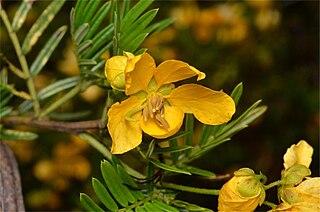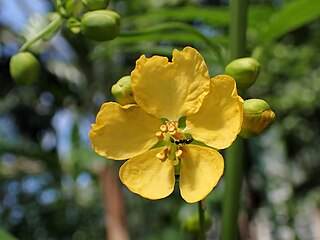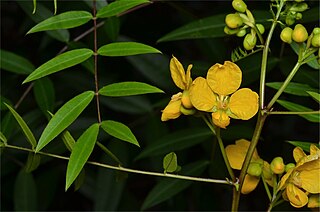
Senna artemisioides, commonly known as silver cassia, is a species of flowering plant in the family Fabaceae and is endemic to Australia, where it is found in all mainland states and territories. It is a small, woody shrub with silver-green leaves and yellow flowers.

Senna acclinis, commonly known as rainforest cassia or brush senna, is a species of flowering plant in the family Fabaceae and is endemic to near-coastal areas of eastern Australia. It is a shrub with pinnate leaves and bright golden yellow flowers in groups of two to five and long, narrow seed pods. It is similar to other species of Senna that are environmental weeds.

Senna aciphylla, commonly known as sprawling senna or Australian senna, is a species of flowering plant in the family Fabaceae and is endemic to eastern Australia. It is a sprawling shrub with pinnate leaves with eight to twelve pairs of linear to narrowly elliptic leaflets, and yellow flowers in pairs or groups of three.

Senna barclayana, commonly known as smooth senna or pepper-leaf senna, is a species of flowering plant in the family Fabaceae and is endemic to eastern Australia. It is a herbaceous perennial or subshrub with pinnate leaves with six to ten pairs of lance-shaped or narrowly elliptic leaflets, and yellow flowers in groups of six to ten.

Senna cardiosperma is a species of flowering plant in the family Fabaceae and is endemic to the western half of Australia. It is an erect shrub or small tree with pinnate leaves, the number and shape of the leaflets depending on subspecies, yellow flowers with ten fertile stamens in each flower, and flat pods.

Senna charlesiana is a species of flowering plant in the family Fabaceae and is endemic to Western Australia. It is an erect shrub with cylindrical leaves, sometimes with one or two pairs of cylindrical leaflets, and yellow flowers arranged in pairs or groups of three or four, with ten fertile stamens in each flower.

Senna circinnata, commonly known as coiled cassia, is a species of flowering plant in the family Fabaceae and is endemic to eastern Australia. It is a shrub or small tree with pinnate leaves with one to three pairs of egg-shaped leaflets, and small groups of yellow flowers in upper leaf axils.
Senna cladophylla is a species of flowering plant in the family Fabaceae and native to Western Australia and the Northern Territory. It is a perennial herb or undershrub with pinnate leaves with two or three pairs of broadly elliptic leaflets, and yellow flowers arranged in pairs, with ten fertile stamens in each flower.

Senna clavigera, commonly known as pepper leaf senna, is a species of flowering plant in the family Fabaceae and is endemic to eastern Australia. It is a perennial herb with pinnate leaves with four to seven pairs of lance-shaped to elliptic leaflets, and groups of four to twenty yellow flowers in upper leaf axils.

Senna coronilloides, commonly known as brigalow senna, is a species of flowering plant in the family Fabaceae and is endemic to eastern Australia. It is an erect, sprawling shrub with pinnate leaves with nine to twelve pairs of elliptic leaflets, and groups of three to five yellow flowers in upper leaf axils.

Senna costata is a species of flowering plant in the family Fabaceae and is endemic to northern Australia. It is a shrub or small tree with pinnate leaves with four or five pairs of narrowly elliptic leaflets, and yellow flowers arranged in pairs or groups of five to eight, with ten fertile stamens in each flower.
Senna curvistyla is a species of flowering plant in the family Fabaceae and is endemic to north-western Australia. It is an undershrub with pinnate leaves with two or three pairs of narrowly elliptic to elliptic leaflets, the flowers yellow and arranged in groups of two or three, with ten fertile stamens in each flower.
Senna cuthbertsonii is a species of flowering plant in the family Fabaceae and is endemic to northern Western Australia. It is a shrub with pinnate leaves with five to nine pairs of elliptic to narrowly egg-shaped leaflets, the flowers yellow and arranged in groups of two to four, with ten fertile stamens in each flower.
Senna ferraria is a species of flowering plant in the family Fabaceae and is endemic to north-western Western Australia. It is an erect shrub with pinnate leaves with three to four pairs of broadly elliptic to egg-shaped leaflets, and yellow flowers arranged in groups of about twelve, with ten fertile stamens in each flower.
Senna flexuosa is a species of flowering plant in the family Fabaceae and is endemic to Western Australia. It is an erect or spreading shrub with pinnate leaves with ten to thirteen pairs of egg-shaped leaflets, and yellow flowers arranged in groups of three to five, with ten fertile stamens in each flower.
Senna glaucifolia is a species of flowering plant in the family Fabaceae and is endemic to arid Central Australia. It is an erect shrub with pinnate leaves with two to four pairs of elliptic leaflets, and yellow flowers arranged in groups of four to seven, with ten fertile stamens in each flower.

Senna glutinosa is a species of flowering plant in the family Fabaceae and is endemic to central and northern arid areas of Australia. It is a shrub or small tree with pinnate leaves with up to seven pairs of leaflets, their shape depending on subspecies, and yellow flowers arranged in groups with ten fertile stamens in each flower.
Senna goniodes is a species of flowering plant in the family Fabaceae and is endemic to the far north of Western Australia. It is an erect, slender shrub with pinnate leaves with two or three pairs of narrowly elliptic to elliptic leaflets, and yellow flowers arranged in groups with ten fertile stamens in each flower.
Senna heptanthera is a species of flowering plant in the family Fabaceae and is endemic to Arnhem Land in the north of the Northern Territory. It is a creeping, herbaceous perennial with pinnate leaves with one or two pairs of broadly egg-shaped leaflets, and yellow flowers arranged in groups of eight to ten, with seven fertile stamens in each flower.
Senna leptoclada is a species of flowering plant in the family Fabaceae and is endemic to Arnhem Land in northern Australia. It is a glaucous, erect to drooping shrub with pinnate leaves usually with two pairs of broadly elliptic leaflets, and yellow flowers arranged in groups of two or three, with ten fertile stamens in each flower.










